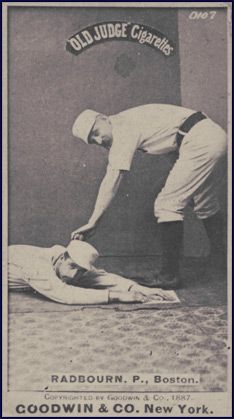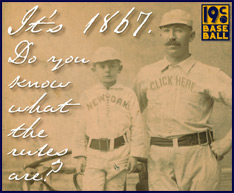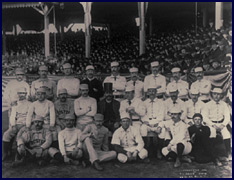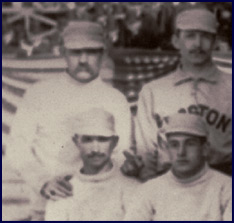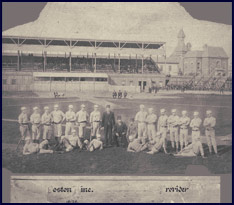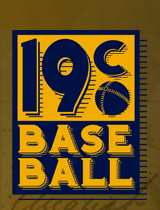Charles “Old Hoss” Radbourn
1854–1897
By Eric Miklich

butcher by trade, CHARLES “OLD HOSS” RADBOURN received his moniker for his incredible endurance and dependability in an era when most teams employed a two-man pitching rotation. As a starting pitcher for the Providence Grays (1881–1885), Boston Beaneaters (1886–1889), Boston Red Stockings (1890) and Cincinnati Reds (1891), Radbourn compiled a 309–195 career record. In 1884 he won the National League's pitching Triple Crown with a 1.38 ERA, 60 wins and 441 strikeouts. His 60 wins in a season is a record which will never be broken.
Once asked if he ever tired of pitching so often, he replied, “Tired out tossing a little five-ounce baseball for two hours? I used to be a butcher. From four in the morning until eight at night I knocked down steers with a 25-pound sledge. Tired from playing 2-hours a day for 10 times the money I used to get for 16 hours a day?”
On July 22, 1884, Providence Grays pitcher Charlie Sweeney, 17-8, misses practice because he is drunk. He starts against the Philadelphia Quakers and, with the Grays ahead, 6-2, in the seventh inning; manager Frank Bancroft brings in Joe "Cyclone" Miller. Sweeney refuses to leave the "box" and is suspended. The Grays play the final two innings with only eight players and lose, 10–6, on eight unearned runs in the ninth inning. Sweeney is kicked off the team and lands in the Union Association with the St. Louis Maroons. Providence is left with only one starting pitcher—Charley “Old Hoss” Radbourn.
The following day, Providence Grays pitcher Radbourn begins what may be the most remarkable feat in baseball history. “Old Hoss” pledges to pitch every game for the rest of the season if the Grays would agree not to reserve him for the following year. He pitches in nine straight games, winning seven, losing one and tying one. He takes a “day off” and plays right field before returning to pitch six more consecutive games. He plays shortstop for a single game and then pitches in 20 more consecutive games, winning 10 before having his 20-game win streak stopped. He would lead the NL in wins with 60, an ERA of 1.38, innings pitches with 678.2, (1.1 innings shy of the record set by Will White, 680, of the Cincinnati Reds in 1879) strikeouts with 441, complete games with 73 and winning percentage with a .833 mark. The Grays would win the pennant by 10½ games over the Boston Beaneaters.
At the close of the season Providence officials accepted New York Metropolitans” (AA) manager Jim Mutrie's challenge to a three game postseason match. All of the games took place at the Polo Grounds in New York and were played under American Association rules, which forbade overhand pitching. This was no hindrance to Radbourn, who threw side arm.
On October 23, 1884, the Providence Grays (NL) whitewash the New York Metropolitans (AA), 6–0, behind Radbourn, in what is considered to be the first official postseason interleague game. Radbourn would allow two hits and strikeout nine. Tim Keefe is the loser.
The very next day, Radbourn three hits the Metropolitans and wins 3–1 in a game called after seven innings due to darkness. Grays third baseman Jerry Denny hits a three-run homer in the fifth inning. It is the first homerun in World Series history. Tim Keefe loses for the second time.
On October 25, 1884 the Providence Grays defeat the New York Metropolitans, 11–2, in the final game of the series. Radbourn wins for the third time in three days. Buck Becannon takes the loss as Tim Keefe, New York Metropolitans losing pitcher in games 1 and 2, umpired the contest.
Radbourn would pitch all three games, allow only 11 hits, strikeout 16, walk none and not allow an earned run. New York would bat .143 against Radbourn. Providence outscored New York 21-3 in winning all three games.
Despite his ability to sign with the club of his choosing, Radbourn remained with the Grays until 1886, when he joined the Boston Beaneaters. It was during his four-year stint with Boston that Radbourn gained notoriety of another sort. During a Boston/New York team photograph in 1886, he became the first public figure to be photographed extending his middle digit to the camera.
After a mediocre tour of duty with the Beaneaters, Radbourn joined the Boston Red Stockings of the Players' League in 1890, where he would lead the short-lived league in winning percentage (.692). The following year, he spent his last major league season with the Cincinnati Reds.
After retiring to Bloomington, Illinois, Radbourn owned and operated a billiard parlor and saloon. He would lose an eye in a hunting accident when his gun discharged accidentally. Less than six years after he threw his last pitch, Charles “Old Hoss” Radbourn died at home of paresis on February 5th, 1897. He was elected to the Baseball Hall of Fame in 1939.
